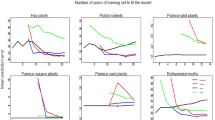Summary
Despite a long history, the term “density dependence” lacks a generally accepted definition. A definition is offered that seems consistent with most other definitions and general usage, that is, a density-dependent factor is any component of the environment whose intensity is correlated with population density and whose action affects survival and reproduction. This definition is used in evaluating the role of territorial behavior, the availability of nest sites, and competition in determining the size of a population. Because neither territory size nor the number of nest sites is correlated with either density or with changes in the birth and death rates of these populations, these cannot be considered density-dependent factors. Competition determines who does breed and who does not rather than the number of breeders, and thus it is not a density-dependent factor determining a population's size.
Similar content being viewed by others
References
Allee WC, Emerson AE, Park O, Park T, Schmidt KP (1949) Principles of animal ecology. Saunders, Philadelphia
Andrewartha HG (1958) The use of conceptual models in population ecology. Cold Spring Harbor Symp Quant Biol 22:219–236
Andrewartha HG (1959) Density-dependent factors in ecology. Nature 183:200
Andrewartha HG, Birch LC (1954) The distribution and abundance of animals. Univ Chicago Press, Chicago
Andrewartha HG, Birch LC (1960) Some recent contributions to the study of the distribution and abundance of insects. Ann Rev Entomol 5:219–242
Birch LC (1958) The role of weather in determining the distribution and abundance of animals. Cold Spring Harbor Symp Quant Biol 22:203–218
Charlesworth B (1980) Evolution in age-structured populations. Cambridge Univ Press, Cambridge
Charlesworth B (1981) Ecological models [review of Murray (1979)]. Ecology 62:1401–1402
Chitty D (1960) Population processes in the vole and their relevance to general theory. Canad J Zool 38:99–113
Chitty D (1967) The natural selection of self-regulatory behaviour in animal populations. Proc Ecol Soc Austra 2:51–78
Hassell MP (1975) Density-dependence in single-species populations. J Anim Ecol 44:283–295
Hassell MP (1981) [Review of Murray (1979)]. J Anim Ecol 50:642–643
Huffaker CB (1958) The concept of balance in nature. Proc Xth Internatl Congr Entomol 2:625–636
Huffaker CB, Messenger PS (1964) Population ecology — historical development. In: P DeBach (ed) Biological control of insect pests and weeds. Reinhold, New York, p 45–73
Lack D (1954) The natural regulation of animal numbers. Oxford Univ Press, London
Lack D (1966) Population studies of birds. Oxford Univ Press, London
May RM (1976) Models for single populations. In: May RM (ed) Theoretical ecology: Principles and applications. Saunders, Philadelphia, p 4–25
Milne A (1958) Perfect and imperfect density dependence in population dynamics. Nature 182:1251–1252
Milne A (1959) A controversial equation in population ecology. Nature 184:1582
Murray BG Jr (1979) Population dynamics: Alternative models. Academic Press, New York
Nicholson AJ (1933) The balance of animal populations. J Anim Ecol 2:132–178
Nicholson AJ (1954a) Compensatory reactions of populations to stresses, and their evolutionary significance. Austral J Zool 2:1–8
Nicholson AJ (1954b) An outline of the dynamics of animal populations. Austral J Zool 2:9–65
Nicholson AJ (1958a) The self-adjustment of populations to change. Cold Spring Harbor Symp Quant Biol 22:153–173
Nicholson AJ (1958b) Dynamics of insect populations. Ann Rev Entomol 3:107–136
Nicholson AJ (1959) Density-dependent factors in ecology. Nature 183:911–912
Nicholson AJ, Bailey VA (1935) The balance of animal populations. Part I. Proc Zool Soc London: 551–598
Pielou EC (1977) Mathematical Ecology. Wiley-Interscience, New York
Ricker WE (1954) Effects of compensatory mortality upon population abundance. J Wildl Manage 18:45–51
Royama T (1977) Population persistence and density dependence. Ecol Monogr 47:1–35
Schwerdtfeger F (1958) Is the density of animal populations regulated by mechanisms or by chance? Proc Xth Internatl Congr Entomol 4:115–122
Smith HS (1935) The rôle of biotic factors in the determination of population densities. J Econ Entomol 28:873–898
Solomon ME (1949) The natural control of animal populations. J Anim Ecol 18:1–35
Solomon ME (1957) Dynamics of insect populations. Ann Rev Entomol 2:121–142
Solomon ME (1958a) Meaning of density-dependence and related terms in population dynamics. Nature 181:1778–1780
Solomon ME (1958b) Perfect and imperfect density dependence in population dynamics. Nature 182:1252
Solomon ME (1959) The meaning of density-dependence and related concepts. Proc XVth Internatl Congr Zool: 784–787
Solomon ME (1964) Analysis of processes involved in the natural control of insects. In: JB Cragg (ed) Advances in ecological research, vol 2. Academic Press, New York-London, p 1–58
Solomon ME (1969) Population Dynamics, Arnold, London
Thompson WR (1939) Biological control and the theories of the interactions of populations. Parasitology 31:299–388
Thompson WR (1956) The fundamental theory of natural and biological control. Ann Rev Entomol 1:379–402
Varley GC (1947) The natural control of population balance in the knapweed gall-fly (Urophora jaceana). J Anim Ecol 16:139–187
Varley GC (1957) Ecology as an experimental science. J Ecol 45:639–648
Varley GC (1958) Meaning of density-dependence and related terms in population dynamics. Nature 181:1780–1781
Varley GC (1959a) Density-dependent factors in ecology. Nature 183:911
Varley GC (1959b) A controversial equation in population ecology. Nature 184:1583
Wynne-Edwards VC (1962) Animal Dispersion in Relation to Social Behaviour. Oliver and Boyd, Edinburgh
Author information
Authors and Affiliations
Rights and permissions
About this article
Cite this article
Murray, B.G. On the meaning of density dependence. Oecologia 53, 370–373 (1982). https://doi.org/10.1007/BF00389016
Received:
Issue Date:
DOI: https://doi.org/10.1007/BF00389016




